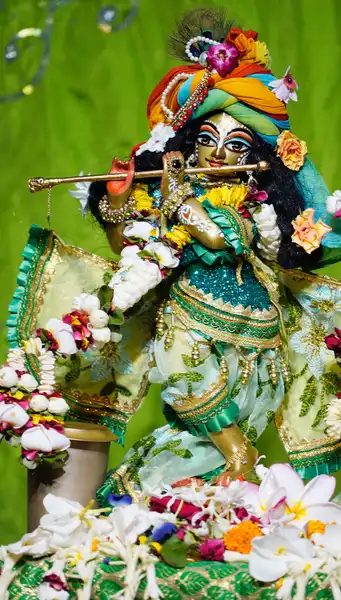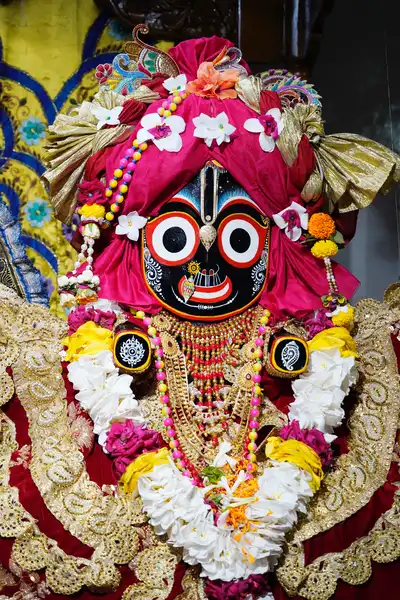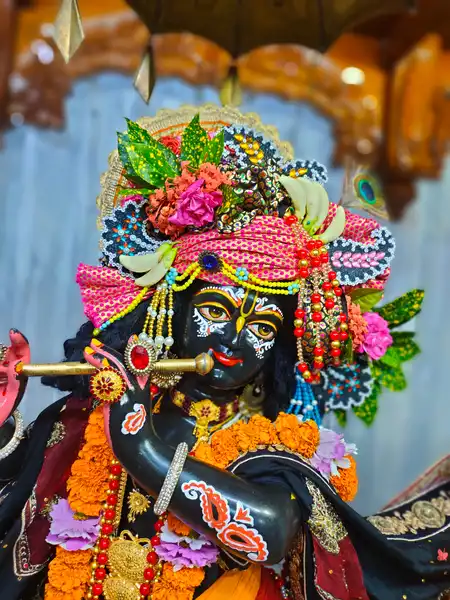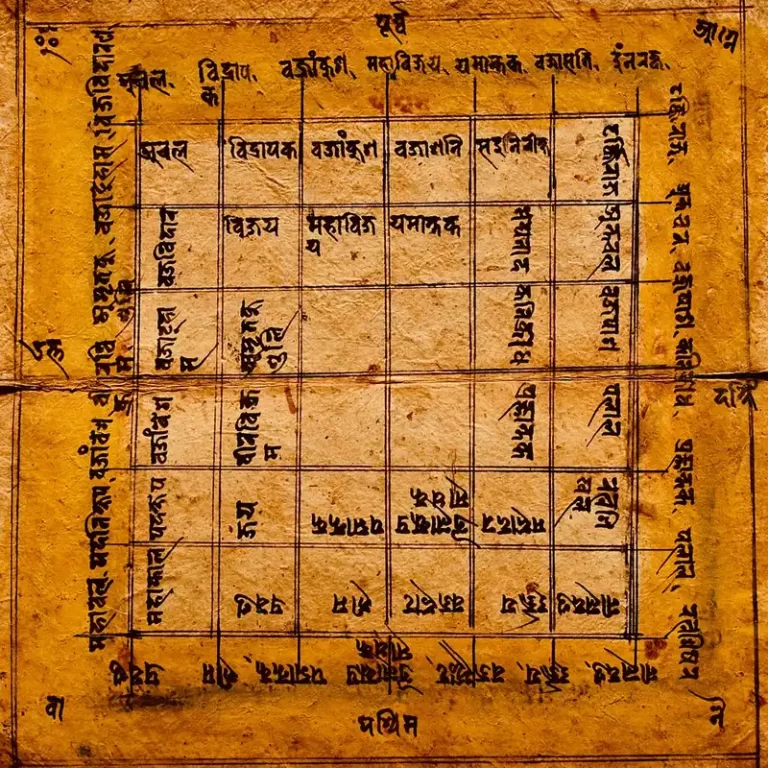Ekadashi Vrata: The Spiritual Significance of Fasting and Devotion
Introduction to Ekadashi Vrata:

Ekadashi Vrata, a Hindu fasting rite, harmonizes spirituality bi-monthly. By refraining from grains and specific foods, symbolizes detachment from materialism and devotion to spiritual advancement. This fasting not only purifies the body but also nurtures mental resilience, portraying the symbiotic relationship between physique and psyche.
Ekadashi Vrata transcends bodily and mental dimensions, unifying human existence’s triad. It stresses that soul nurturing equals bodily nourishment. Beyond food restrictions, participants delve into prayer, meditation, and self-exploration, attaining profound spiritual harmony. This rite epitomizes fasting’s role as a bridge between tangible life aspects and intangible soul aspirations.
The Concept and Occurrence of Ekadashi Vrata:
The etymology of “Ekadashi” hails from Sanskrit, where “eka” (one) and “dashi” (ten) amalgamate as “eleventh day.” This term designates the 11th day of each lunar month in the Hindu calendar. Interestingly, this unique fasting custom recurs bi-monthly—once during the moon’s waxing phase and again during its waning phase. This dual occurrence underscores the intricate link between cosmic rhythms and spiritual traditions.
Ekadashi Vrata emerges as a sacred fasting and devotion day as the moon shifts from new to full (waxing) and full to new (waning) phases. These phases embody distinct energies: waxing signifies growth and ascent, and waning conveys decline and introspection. Ekadashi’s presence in both magnifies spirituality’s comprehensive essence, encompassing diverse aspects of the human journey.
This rhythm aligns Ekadashi Vrata with the lunar calendar, accentuating its role in connecting the earthly and celestial spheres. The lunar calendar has been pivotal across cultures, regulating time and impacting cultural and religious norms. Ekadashi Vrata’s integration into this lunar fabric further underscores its status as a spiritual focal point, enabling adherents to synchronize with cosmic ebbs and flows.
Ekadashi Vrata encapsulates the intricate interplay of time, heritage, and spirituality. Bi-monthly occurrence, mirroring the moon’s voyage, echoes life’s cyclic nature and the perennial quest for equilibrium. By harmonizing with the lunar calendar, Ekadashi Vrata not only embeds in cosmic cadence but also offers a profound avenue for individuals to align their inner realm with the broader cosmos. This fosters unity and resonance transcending temporal and spatial confines.
Spiritual Significance of Ekadashi Vrata:

The practice of Ekadashi Vrata is intricately woven with spiritual significance, rooted in Hindu philosophy and a quest for elevated consciousness. Fasting on Ekadashi surpasses mere physical abstinence; it’s a profound endeavor to elevate spiritual states. The rationale behind this practice is multifaceted, embracing both bodily and mental purification.
Ekadashi fasting serves as a body purification rite. By abstaining from certain foods, the digestive system rests, detoxifying and regenerating. This practice rejuvenates the body, fostering physical wellness. Moreover, fasting nurtures mental lucidity and self-control. The restraint practiced during fasting enhances the ability to govern desires and impulses, cultivating enhanced self-mastery.
In the spiritual sphere, Ekadashi Vrata intensifies devotion and connection with the divine. As body and mind purify, the spirit sheds material attachments, facilitating a deeper divine communion. Fasting on this day creates an environment for introspection, meditation, and prayer, heightening the spiritual experience.
Additionally, fasting is seen as an offering to the divine. By voluntarily abstaining from physical sustenance, individuals prioritize spiritual nourishment, displaying devotion and faith commitment. This sacrifice draws divine attention, forging an intimate individual-transcendent connection.
The self-control demonstrated during Ekadashi Vrata reverberates beyond fasting days. The discipline cultivated extends to increased self-awareness and better decision-making in daily life. This infusion of spiritual principles into actions nurtures personal growth in material and spiritual realms.
Types of Ekadashi Vrata:
The Hindu calendar is punctuated by a succession of Ekadashi observances, each with its unique significance and narratives. These Ekadashi days offer devotees varied prospects for spiritual introspection and devotion.
Nirjala Ekadashi, renowned as “waterless fasting,” stands out. Amid the hot months, it’s deemed the most stringent Ekadashi. Devotees rigorously fast, eschewing both food and water the entire day. This stern practice stems from sage Bhima, who, due to his insatiable appetite, consulted Lord Krishna. Krishna recommended Nirjala Ekadashi to bestow the spiritual merits of a year’s Ekadashis. It symbolizes utmost devotion and self-control.
Vaikunta Ekadashi is another prominent occasion, celebrated ardently in honor of Lord Vishnu. This day marks the opening of Vaikunta’s celestial gates (Vishnu’s heavenly abode). Believers deem passage through these gates grants direct divine access. Temples dedicated to Vishnu conduct special rites and prayers. Vaikunta Ekadashi underscores surrender and devotion, aiming to escape the cycle of birth and death for eternal union with Vishnu.
The array of Ekadashi Vrata observances likewise enwraps poignant narratives and rituals. Kamika Ekadashi signifies sin purging through fasting and worship. Apara Ekadashi spotlights charity and altruistic giving. Each Ekadashi narrates a distinct tale, often illustrating the importance of dharma adherence, devotion, and soul transformation.
Rituals and Observances:

The practice of Ekadashi Vrata intertwines dietary regulation, spiritual devotion, and self-awareness. Devotees embrace a set of fasting guidelines and partake in specific spiritual endeavors to honor this sacred day fully.
The fasting principles for Ekadashi encompass more than dietary constraints. Followers refrain from grains, beans, select vegetables, and even particular spices. This approach minimizes the intake of heavy and tamasic foods, fostering purity and lightness. Moreover, avoiding behaviors such as falsehood, anger, and negative speech is advocated. This comprehensive method extends fasting to the body and mind, purifying physical, mental, and emotional dimensions.
At the heart of Ekadashi Vrata lies a focus on spiritual practices. Practitioners devote extended time to prayer and meditation, forging a deeper connection with the divine. Mantra recitation and scripture reading, often linked to Lord Vishnu or the chosen deity, are common. These practices instill inner tranquility, introspection, and alignment with the higher self. Reading sacred texts is viewed as absorbing divine wisdom, and guiding one’s spiritual journey.
Additionally, visiting temples or participating in congregational gatherings holds great significance on Ekadashi. Numerous temples arrange special services encompassing discourses, bhajans (devotional songs), and collective prayers. These group endeavors amplify the day’s spiritual energy, nurturing unity among devotees and fostering an intensified bond with the divine.
Benefits of Ekadashi Vrata:
Participating in Ekadashi Vrata brings forth an array of physical and spiritual advantages, seamlessly intertwining bodily health with soul elevation. The act of fasting on this sacred day is believed to establish a harmonious fusion between the physical and the spiritual domains.
From a physical perspective, fasting during Ekadashi is thought to grant the body a much-desired respite from the digestive process. By refraining from dense and hard-to-digest foods, the digestive system can rest and regenerate. This pause in food intake potentially leads to enhanced digestion, improved metabolism, and even potential benefits in weight management. Moreover, the body’s energy shifts from digestion to repair and upkeep activities, contributing to overall physical vigor.
Regarding detoxification, fasting on Ekadashi may aid the body’s innate cleansing mechanisms. By sidestepping certain foods, the body is relieved of breaking down intricate substances, allowing it to allocate resources to detoxify and expel accumulated waste. This detox process could potentially result in better skin health, heightened energy levels, and a sensation of lightness in the body.
On the mental and spiritual level, fasting on Ekadashi is believed to purify the mind and elevate mental clarity. As the body purifies, mental lucidity is thought to follow suit. The self-control practiced during fasting also fosters a sense of discipline and dominion over desires, amplifying the capacity for concentration and introspection. The tranquility cultivated through prayer and meditation during Ekadashi might lead to a more serene mind and an augmented sense of tranquility and wellness.
Furthermore, fasting on Ekadashi presents a prospect to transcend physical desires and cultivate a deeper affinity with the divine. By temporarily relinquishing material comforts, individuals can tap into an augmented spiritual state, nurturing their connection with the divine and concentrating on their spiritual journey. This practice accentuates the interconnectedness of body, mind, and soul, elucidating how their alignment can yield holistic well-being.
Story and Mythology:

The practice of Ekadashi is adorned with a vibrant tapestry of stories and myths that trace its origins and convey profound spiritual wisdom. These narratives illuminate the practice’s significance, intertwining it with timeless moral teachings.
Among these cherished narratives is the dialogue between King Yudhishthira and Lord Krishna in the Mahabharata. Curious about spiritual purification, Yudhishthira questioned Krishna, who revealed that observing Ekadashi yields spiritual merits akin to various austerities. This tale emphasizes Ekadashi’s all-encompassing spiritual value, encompassing numerous virtues within its observance.
The story of Bhima, a Pandava prince, underscores Ekadashi’s transformative potency. His insatiable appetite hindered regular observances. Seeking a remedy, he turned to Lord Krishna, who advised him to observe Nirjala Ekadashi, fasting from food and water. Bhima’s devotion exemplified spiritual growth potential, showing intentions matter as much as actions.
These narratives impart profound moral and spiritual teachings. They stress self-discipline, sacrifice, and devotion, highlighting the significance of aligning actions with higher principles. Ekadashi becomes a realm for practicing self-control, nurturing divine connections, and transcending comfort zones. These stories reveal that spiritual journeys demand dedication, resilience, and a readiness to surpass personal limitations.
Cultural and Regional Practices:
The practice of Ekadashi Vrata unfolds in captivating diversity across various regions and communities within the expansive canvas of Hinduism. This diversity is echoed in customs, rituals, and even dietary choices linked to Ekadashi fasting, highlighting the imprint of local traditions on this revered practice.
The variations in Ekadashi observance stem from the vastness of Hindu culture, adapting to different geographical and cultural landscapes. In certain regions, specific Ekadashi days hold heightened auspiciousness, eliciting unique rituals and fervor. North Indian devotees amplify Vaikunta Ekadashi, while Swaminarayan followers embrace Annakut festivities on this day.
The customs and rituals accompanying Ekadashi are equally diverse. Some communities engage in acts of charity or selfless service. Ritual practices encompass an array, from intricate temple rites to personal home-based worship. Many groups partake in collective prayers, devotional songs, and discussions to elevate Ekadashi’s spiritual ambiance.
Food assumes significance in Ekadashi fasting, with distinct dietary regulations and preferences diverging across regions. While grains are universally avoided, permissible foods exhibit variation. Some groups refrain from all grains, including rice and wheat, while others permit specific grains like buckwheat or millet. Diverse culinary creations arise from permissible ingredients, reflecting local cuisines’ adaptability to Ekadashi guidelines.
The sway of local traditions on Ekadashi observance is palpable. In South India, the focus intensifies on the Ekadashi associated with Lord Vishnu’s incarnation as Lord Krishna – Janmashtami. Celebrations are vibrant, often accompanied by grand temple processions. In contrast, Western Indian communities may emphasize Ekadashis linked to specific deities like Lord Shiva or Goddess Durga.
Challenges and Guidance:

While Ekadashi Vrata offers spiritual rewards, it also presents its share of challenges. Individuals may face a spectrum of difficulties, ranging from physical discomfort due to fasting to sustaining required spiritual concentration amidst daily obligations.
Managing hunger and maintaining energy levels emerges as a common obstacle. Fasting might lead to weakness and fatigue, especially for newcomers or those with specific health conditions. Moreover, resisting cravings for prohibited foods can entail mental strain.
Overcoming these challenges necessitates a prepared and mindful approach to Ekadashi. Adequate hydration before the fast commences can alleviate physical discomfort. Consuming easily digestible foods on the day before and after Ekadashi can smoothen the transition. Embracing permissible foods during the fast can provide sustenance within the prescribed guidelines.
Sustaining spiritual focus amid hectic schedules is equally taxing. Daily responsibilities, work, and familial commitments can vie for attention. Allocating time for spiritual practices like meditation, prayer, and scripture reading is pivotal. Weaving these practices into daily routines can establish a consistent spiritual cadence.
For those new to Ekadashi fasting, practical advice can facilitate a smoother transition. Gradually reducing heavy food intake a day or two prior can prevent abrupt hunger on the fasting day. Crafting simple, nourishing meals in line with fasting rules prevents last-minute confusion. Establishing a support network, such as partaking in communal prayers or fasting with family members, can provide encouragement and accountability.
Remaining aligned with Ekadashi’s purpose and concentrating on spiritual gains can motivate individuals to surmount challenges. Recollecting associated stories and teachings can infuse the observance with profound meaning. Nurturing mindfulness and gratitude throughout the day maintains a positive outlook.
Contemporary Relevance and Mindful Practices:
Amid the whirlwind of modern living, the integration of mindful practices has evolved into a necessity. Mindfulness offers a potent antidote to the ceaseless distractions and pressures of contemporary existence, furnishing a route to inner serenity, self-awareness, and a more profound purpose. Ekadashi Vrata, underscored by deliberate fasting and spiritual engagement, stands as a timeless illustration of how mindful practices can harmonize with our lives.
Ekadashi Vrata champions mindfulness by urging individuals to be wholly present in their actions and choices. Fasting transforms into a deliberate act, heightening awareness of what is ingested, both physically and mentally. This augmented consciousness extends beyond sustenance to encompass thoughts, language, and conduct. The act of abstaining from specific behaviors and foods stimulates introspection on habits, yearnings, and attachments, cultivating a deeper comprehension of oneself and motives.
Moreover, Ekadashi Vrata fosters self-awareness through introspection and contemplation. Prayer, meditation, and scripture perusal create pockets of stillness amid life’s chaos. These practices foster self-scrutiny, enabling the recognition of patterns, emotions, and thought flows. Such self-awareness is the bedrock of mindfulness, empowering conscious decisions and responses steeped in greater equanimity.
A balanced approach to Ekadashi fasting requires tools and resources to fortify the path toward mindfulness. Forethought and preparation hold significance; an array of permissible foods and familiarity with recipes can avert spontaneous temptations. Digital calendars or apps pinpointing Ekadashi dates help individuals stay informed and plan effectively. Engaging in communal endeavors or joining online communities extends support, exchanges tips, and forges a shared sense of commitment.
Conclusion:
Ekadashi Vrata reverberates with profound spiritual import as a practice that forges a link between the physical and the spiritual domains. Beyond being a mere fasting ritual, it signifies a voyage of self-purification, self-discipline, and devotion. The act of fasting on Ekadashi extends beyond physical health, encompassing the elevation of the soul.
Ekadashi Vrata epitomizes the imperative of harmonizing body, mind, and spirit in the quest for elevated consciousness. By abstaining from specific nourishment and behaviors, individuals cleanse their physical being, revitalize their minds, and unfold their hearts to a profound rapport with the divine. Fasting transforms into a symbolic offering, signifying one’s commitment to spiritual advancement and self-mastery.
I aspire for this article to provide you with assistance. Should you discover value within these words, kindly contemplate sharing them with your loved ones. I invite you to spare a moment to offer your thoughts and appraisals below. For further remarkable content akin to this, I encourage you to delve into our website. Additionally, I extend an invitation to subscribe to my YouTube channel for forthcoming materials of similar nature. Lastly, feel unrestrained to establish a connection with me through social media. Wishing you a splendid day ahead!
हरि ॐ तत्सत्
FAQs:
Here are some frequently asked questions (FAQs) regarding the Ekadashi Vrata:





